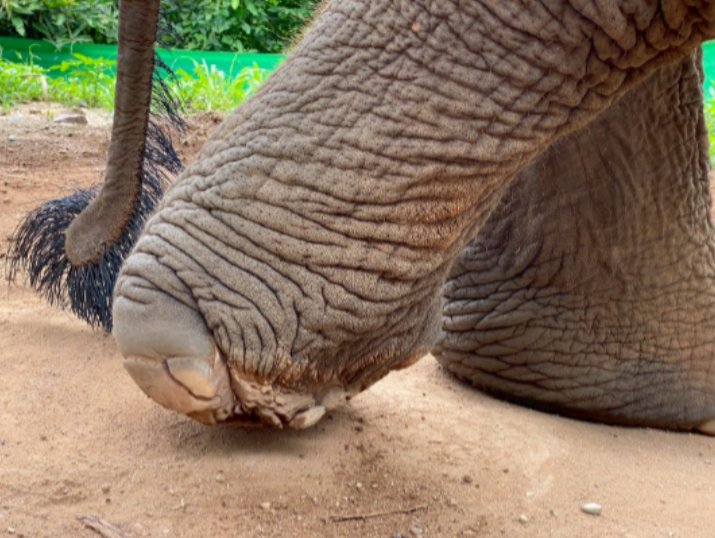June started as a relatively quiet month for the Chiang Mai University Mobile Vet Clinic team. Their first case was the successful check up on a calf that had previously been diagnosed with EEHV. After that, it was relatively quiet for two weeks until several cases popped up in the last two weeks of the month. There were multiple gastrointestinal cases and several musculoskeletal cases. Thankfully, virtually all cases this month ended with a positive prognosis!
It had been nearly two weeks since a 7-year-old male elephant was diagnosed with and recovered from EEHV type 4 infection. The CMU Mobile Clinic veterinarian visited the camp to conduct a follow-up and collected a blood sample for final monitoring. The results showed all parameters within normal ranges. At present, the elephant appeared bright, alert, and in good health!
Within a week of each other, four cases presenting with gastrointestinal discomfort were reported to
the CMU vets. In the first case, the elderly elephant presented with a loss of appetite, large amounts of soil in her feces, and concerns of bloating. The team advised a walk for the elephant along with an anti- flatulent medication. Upon arrival, the vets administered a pain relief injection and activated charcoal with simethicone to support gut function. Since her condition had improved, no further treatment was necessary and the vets left recommendations to supplement her diet with salt and minerals for overall health benefits.
Elderly cow eating post-treatment
A week later the CMU Mobile Vets were called out to another location where an adult female elephant was showing signs of colic. She had passed only a small amount of feces that morning and had refused both food and water. Prior to the team’s arrival, the mahout had taken her for a walk uphill to stimulate gastrointestinal motility. Upon arrival, the vets were informed that a second elephant, her sister, was also experiencing gastrointestinal symptoms. The first elephant appeared depressed with signs of gas accumulation, while the second had developed watery diarrhea. The vets began by examining the more severely affected elephant, who had an absence of feces and was beginning to develop a fever. She was given intravenous fluid therapy, a pain reliever, an intestinal stimulant was administered, and rectal enema. She began eating bananas shortly after the passage of a large amount of feces. She was encouraged to continue walking, which led to further improvement. The second elephant, meanwhile, had strong gut sounds. While preparing her medications, she passed watery diarrhea along with an
unfamiliar intestinal parasite. A sample was collected for identification and after receiving a pain reliever and antispasmodic medication, she appeared more comfortable and resumed eating. By the following day, both elephants had gradually returned to normal eating and drinking behavior.
Sisters who were treated for gastrointestinal discomfort
While working in Mae Wang, the CMU team received a call in the evening from a camp manager
reporting that one of their elephants had a nail issue. The elephant had previously suffered from a land mine during her youth while living near the border. Although the wound had healed, it left her foot permanently deformed, affecting her gait and weight-bearing ability. Concerned that the nail injury might be serious, the vets visited the camp for an assessment. Fortunately, it turned out to be a minor issue. A small portion of the nail surface was torn and twisted. The veterinarian trimmed the affected area using a hoof knife to prevent further damage.
Foot of mine injured elephant before (left) and after (right) minor nail care
Later in the month, a call came in from an elephant owner regarding a female elephant showing signs of lameness. She is currently caring for a young calf. According to the mahout, the elephant had shown mild lameness for about five days, but continued to eat well and was able to lie down at night as usual. Upon examination, gait analysis revealed that she was able to bear weight on all of her limbs and flex her joints properly. However, mild lameness was noted in the right forelimb. A thermal scan identified a warm spot over the dorsal carpal area, where a small superficial cut was observed. Pain relief medication and topical massage oil were administered. Additionally, the vets recommended rest until she has fully recovered.
Mom elephant has leg imaged with thermal scan while her baby waits with their mahout
On the morning of June 30, the team received a video clip from the owner showing a 3-year-old juvenile elephant with apparent lameness. In the footage, the elephant was walking while lifting his left foreleg, raising concern for a potentially serious injury. The veterinarian inquired about any possible causes. According to the mahout, the elephant had been frightened the previous afternoon and ran into the forest. Due to the rainy and muddy conditions, it was suspected he might have slipped. The next morning, the mahout found the elephant avoiding the use of his left forelimb. However, after additional photos and videos were sent, the situation seemed less severe. The elephant was able to walk and bear weight on all limbs, though mild swelling was observed around the left carpal joint. Initially, the team was quite concerned about a possible fracture. Although the procedure was challenging due to the young elephant’s lack of training, vets were able to perform an x-ray and confirm that no fractures were present. Pain relief medication was administered, and cold compresses were attempted, although the calf was not very cooperative with the treatment. Continued monitoring and rest were advised.
Young calf finally stands still for x-ray of affected left forelimb
We are so grateful for the continuing efforts of the Chiang Mai University Mobile Vet Clinic Team! Help AES continue to support them as they strive to make a better future for Thai elephants, by donating TODAY at www.asianelephantsupport.org/donate






